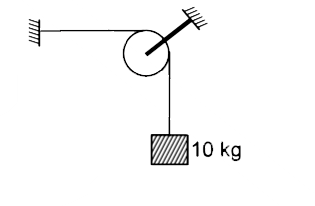Let F1 be the magnitude of the gravitational force exerted on the Sun by Earth and F2 be the magnitude of the force exerted on Earth by the Sun. Then:
F1 is much greater than F2
F1 is slightly greater than F2
F1 is equal to F2
F1 is slightly less than F2
The correct Answer is:C
To solve the problem, we need to analyze the gravitational forces exerted between the Earth and the Sun using Newton's Law of Gravitation.
1. Understanding the Gravitational Force: According to Newton's Law of Gravitation, the gravitational force F between two masses m1 and m2 separated by a distance r is given by the formula:
F=Gm1m2r2
where G is the gravitational constant.
2. Identifying the Forces: In our case:
- Let ms be the mass of the Sun.
- Let me be the mass of the Earth.
- The distance between the Earth and the Sun is r.
The gravitational force exerted on the Sun by the Earth is denoted as F1, and the gravitational force exerted on the Earth by the Sun is denoted as F2.
3. Applying the Formula:
- The gravitational force F1 (force on the Sun due to Earth) can be expressed as:
F1=Gmemsr2
- The gravitational force F2 (force on the Earth due to Sun) can be expressed as:
F2=Gmsmer2
4. Comparing the Forces: From the equations for F1 and F2, we can see that:
F1=F2
This shows that the magnitudes of the gravitational forces are equal.
5. Conclusion: According to Newton's Third Law of Motion, for every action, there is an equal and opposite reaction. Thus, the gravitational force exerted by the Earth on the Sun is equal in magnitude and opposite in direction to the gravitational force exerted by the Sun on the Earth.
Final Answer:
F1=F2
F=Gm1m2r2
where G is the gravitational constant.
- Let ms be the mass of the Sun.
- Let me be the mass of the Earth.
- The distance between the Earth and the Sun is r.
- The gravitational force F1 (force on the Sun due to Earth) can be expressed as:
F1=Gmemsr2
- The gravitational force F2 (force on the Earth due to Sun) can be expressed as:
F2=Gmsmer2
F1=F2
This shows that the magnitudes of the gravitational forces are equal.
F1=F2
Similar Questions
Knowledge Check
The gravitational force exerted by the earth on a body is called
Aweight of the bodyBacceleration of that bodyCmass of the bodyDgravitational constantA marble is dropped straight down from a distance h above the floor.
Let Fm = the magnitude of the gravitational force on the marble due to the Earth,
Fe = the magnitude of the gravitational force on the Earth due to the marble,
am = the magnitude of the acceleration of the marble toward the Earth,
ae = the magnitude of the acceleration of the Earth toward the marble.
Which set of conditions is true as the marble falls toward the earth? Neglect any effects of air resistance.AFm=Fe and am<aeBFm<Fe and am>aeCFm<Fe and am=aeDFm=Fe and am>aeThe magnitude of the gravitational force will be equal to the _________.
Aproduct of mass and acceleration due to the gravitational forceBratio of mass and acceleration due to the gravitational forceCratio of acceleration due to the gravitational force and massDreciprocal of product of mass and acceleration due to the gravitational force.
If magnitude of the gravitational force between the earth and the mon is denoted by A and between the earth and the sun by B then
View SolutionAn apple falls from a tree because of gravitational between the earth and apple. If F1 is the magnitude of force exerted by the earth on the apple and F2 is the magnitude of force exerted by apple on earth, then
View SolutionThe magnitude of electric force, F is
View SolutionThe gravitational force with which the sun attracts the earth ?
View SolutionAn apple falls from a tree because of gravitational between the earth and apple. If F1 is the magnitude of force exerted by the earth on the apple and F2 is the magnitude of force exerted by apple on earth, then
View Solution


